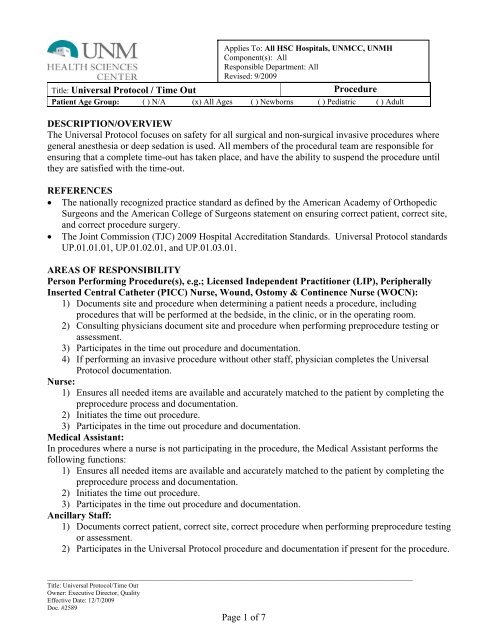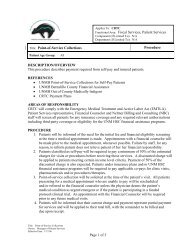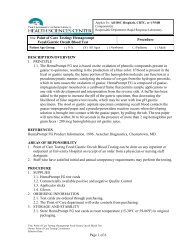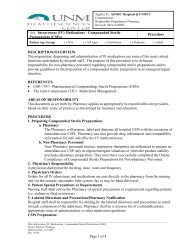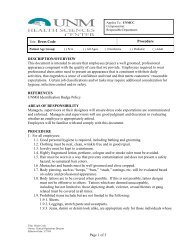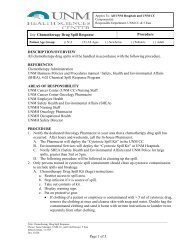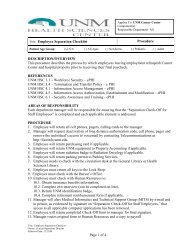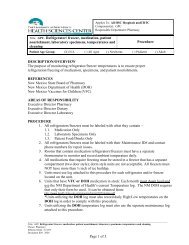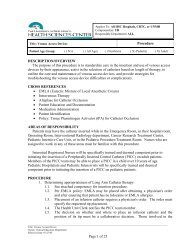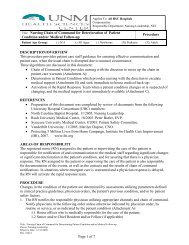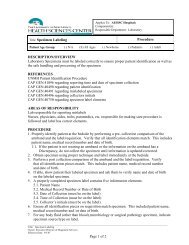Non-OR Universal Protocol/Time Out - UNM Cancer Center
Non-OR Universal Protocol/Time Out - UNM Cancer Center
Non-OR Universal Protocol/Time Out - UNM Cancer Center
You also want an ePaper? Increase the reach of your titles
YUMPU automatically turns print PDFs into web optimized ePapers that Google loves.
Applies To: All HSC Hospitals, <strong>UNM</strong>CC, <strong>UNM</strong>H<br />
Component(s): All<br />
Responsible Department: All<br />
Revised: 9/2009<br />
Title: <strong>Universal</strong> <strong>Protocol</strong> / <strong>Time</strong> <strong>Out</strong><br />
Procedure<br />
Patient Age Group: ( ) N/A (x) All Ages ( ) Newborns ( ) Pediatric ( ) Adult<br />
DESCRIPTION/OVERVIEW<br />
The <strong>Universal</strong> <strong>Protocol</strong> focuses on safety for all surgical and non-surgical invasive procedures where<br />
general anesthesia or deep sedation is used. All members of the procedural team are responsible for<br />
ensuring that a complete time-out has taken place, and have the ability to suspend the procedure until<br />
they are satisfied with the time-out.<br />
REFERENCES<br />
The nationally recognized practice standard as defined by the American Academy of Orthopedic<br />
Surgeons and the American College of Surgeons statement on ensuring correct patient, correct site,<br />
and correct procedure surgery.<br />
The Joint Commission (TJC) 2009 Hospital Accreditation Standards. <strong>Universal</strong> <strong>Protocol</strong> standards<br />
UP.01.01.01, UP.01.02.01, and UP.01.03.01.<br />
AREAS OF RESPONSIBILITY<br />
Person Performing Procedure(s), e.g.; Licensed Independent Practitioner (LIP), Peripherally<br />
Inserted Central Catheter (PICC) Nurse, Wound, Ostomy & Continence Nurse (WOCN):<br />
1) Documents site and procedure when determining a patient needs a procedure, including<br />
procedures that will be performed at the bedside, in the clinic, or in the operating room.<br />
2) Consulting physicians document site and procedure when performing preprocedure testing or<br />
assessment.<br />
3) Participates in the time out procedure and documentation.<br />
4) If performing an invasive procedure without other staff, physician completes the <strong>Universal</strong><br />
<strong>Protocol</strong> documentation.<br />
Nurse:<br />
1) Ensures all needed items are available and accurately matched to the patient by completing the<br />
preprocedure process and documentation.<br />
2) Initiates the time out procedure.<br />
3) Participates in the time out procedure and documentation.<br />
Medical Assistant:<br />
In procedures where a nurse is not participating in the procedure, the Medical Assistant performs the<br />
following functions:<br />
1) Ensures all needed items are available and accurately matched to the patient by completing the<br />
preprocedure process and documentation.<br />
2) Initiates the time out procedure.<br />
3) Participates in the time out procedure and documentation.<br />
Ancillary Staff:<br />
1) Documents correct patient, correct site, correct procedure when performing preprocedure testing<br />
or assessment.<br />
2) Participates in the <strong>Universal</strong> <strong>Protocol</strong> procedure and documentation if present for the procedure.<br />
_________________________________________________________________________________________________________________<br />
Title: <strong>Universal</strong> <strong>Protocol</strong>/<strong>Time</strong> <strong>Out</strong><br />
Owner: Executive Director, Quality<br />
Effective Date: 12/7/2009<br />
Doc. #2589<br />
Page 1 of 7
PROCEDURE<br />
I. <strong>Non</strong>-Operating Room Invasive Procedures:<br />
Conduct a pre-procedure verification process.<br />
1) Verification of the correct person, correct site, and correct procedure occurs at the following<br />
times:<br />
1.1 At the time the procedure is scheduled<br />
1.2 At the time of preadmission testing and assessment<br />
1.3 At the time of admission or entry into the facility for a procedure, whether elective or<br />
emergent<br />
1.4 Before the patient leaves the preprocedure area or enters the procedure room<br />
1.5 Anytime the responsibility for care of the patient is transferred to another member of the<br />
procedural care team, including the anesthesia providers, at the time of, and during, the<br />
procedure.<br />
2 The preprocedure verification is a process of information gathering and verification.<br />
2.1 The nurse (or physician if the nurse is not involved in the procedure) conducts the<br />
preprocedure verification process to ensure that all relevant documents and related<br />
information or equipment are:<br />
2.1.1 Available prior to the start of the procedure.<br />
2.1.2 Correctly identified, labeled, and matched to the patient’s identifiers.<br />
2.1.3 Reviewed and are consistent with the patient’s expectations and with the team’s<br />
understanding of the intended patient, procedure, and site.<br />
2.2 Preprocedure verification includes:<br />
2.2.1 Correct patient<br />
2.2.2 Correct procedure<br />
2.2.3 Correct site<br />
2.2.4 Procedural and sedation consents<br />
2.2.5 Site marking, if applicable<br />
2.2.6 Relevant documentation<br />
2.2.6.1 For example, history and physical, signed procedure consent form,<br />
nursing assessment, and preanesthesia assessment.<br />
2.2.7 Correct and labeled test results present<br />
2.2.7.1 For example, radiology images and scans, or pathology and biopsy<br />
reports) that are properly displayed<br />
2.2.8 Any required blood products, implants, devices, and/or special equipment for the<br />
procedure<br />
Mark the procedure site<br />
1. Marking the procedure site allows staff to identify without ambiguity the intended site for the<br />
procedure. (For those procedures in which site marking is not required, the other requirements of<br />
the <strong>Universal</strong> <strong>Protocol</strong> still apply.)<br />
2. For all procedures involving incision or percutaneous puncture or insertion, where laterality and/or<br />
level are involved, the intended procedure site is marked.<br />
Note: For procedures that involve laterality of organs, but the incision(s) or approaches may be<br />
from the midline or from a natural orifice, the site is still marked and the laterality noted.<br />
3. The site marking takes place with the patient involved, awake and aware prior to prepping and<br />
draping, if possible.<br />
4. The procedure site is marked by a licensed independent practitioner or other provider who is<br />
permitted by the hospital and qualified through a residency program to perform the procedure. This<br />
_________________________________________________________________________________________________________________<br />
Title: <strong>Universal</strong> <strong>Protocol</strong>/<strong>Time</strong> <strong>Out</strong><br />
Owner: Executive Director, Quality<br />
Effective Date: 12/7/2009<br />
Doc. #2589<br />
Page 2 of 7
individual will be involved directly in the procedure and will be present at the time the procedure is<br />
performed.<br />
4.1. Note: Final confirmation and verification of the site mark takes place during the time-out.<br />
5. The site is marked with a site-marking pen, and is designated by the initials of the LIP marking the<br />
site.<br />
6. For patients who refuse site marking or when it is technically or anatomically impossible or<br />
impractical to mark the site (mucosal surfaces, perineum, premature infants), follow an alternative<br />
process and note patient refusal on the <strong>Universal</strong> <strong>Protocol</strong> documentation.<br />
6.1. A wrist band will be placed on the patient, stating the patient’s name and the procedure being<br />
performed.<br />
6.2. If the procedure relates to laterality, a wristband will be placed on the patient stating the<br />
procedure and patient’s name..<br />
6.3. Examples of other situations which may involve alternative processes include:<br />
6.3.1. Minimal access procedures treating a lateralized internal organ, whether percutaneous or<br />
through a natural orifice<br />
6.3.2. Interventional procedure cases for which the catheter/instrument insertion site is not<br />
predetermined (for example, cardiac catheterization, pacemaker insertion)<br />
6.3.3. Teeth<br />
6.3.4. Premature infants, for whom the mark may cause a permanent tattoo<br />
7. Exceptions to Site Marking:<br />
7.1. Procedures in which there is no predetermined site of insertion such as cardiac catheterization<br />
and other interventional procedures.<br />
7.2. An obvious wound or lesion that is the site of the intended procedure.<br />
7.3. When the person performing the procedure does not leave the patient once the decision is<br />
made to perform the procedure…for example an emergent bedside procedure.<br />
7.4. Site markings are not required for epidural anesthesia for the patient in labor.<br />
<strong>Time</strong> <strong>Out</strong><br />
1. A time-out is conducted immediately prior to starting the invasive procedure or making the incision.<br />
The purpose of the time-out immediately before starting the procedure is to conduct a final<br />
assessment that the correct patient, correct site, and correct procedure are identified. The time-out<br />
has the following characteristics:<br />
1.1 It is standardized by following this policy and procedure, and documenting on one of<br />
the approved forms. The time-out includes the following:<br />
1.1.1 Correct patient identification<br />
1.1.2 Correct site<br />
1.1.3 Correct procedure<br />
1.2 It is initiated by the designated team member.<br />
1.3 It involves the immediate members of the procedure team.<br />
1.4 When two or more procedures are being performed on the same patient, and the<br />
person performing the procedure changes, a time-out is performed to confirm each<br />
subsequent procedure before it is initiated.<br />
1.5 Exceptions to <strong>Time</strong> <strong>Out</strong>:<br />
1.5.1 A time-out is not required for procedures for pain management,<br />
such as cervical & lumbar epidural injections if the person<br />
performing the procedure does not leave the patient once he/she<br />
enters the room to perform the procedure.<br />
Documentation:<br />
_________________________________________________________________________________________________________________<br />
Title: <strong>Universal</strong> <strong>Protocol</strong>/<strong>Time</strong> <strong>Out</strong><br />
Owner: Executive Director, Quality<br />
Effective Date: 12/7/2009<br />
Doc. #2589<br />
Page 3 of 7
1. The <strong>Universal</strong> <strong>Protocol</strong> is clearly documented using one of the following options.<br />
1.1. <strong>Non</strong>-<strong>OR</strong> <strong>Universal</strong> <strong>Protocol</strong> Form<br />
1.2. Procedural Sedation Flow sheet<br />
II. Surgical Services Invasive Procedures:<br />
Conduct a pre-procedure verification process<br />
1. Each inpatient and outpatient area performing elective or urgent invasive procedures which<br />
require specific informed consent will participate in a preprocedure prior to start of the<br />
procedure. Documentation of the preprocedure can be on the time out checklist, time out sticker,<br />
nursing record or in the designated area on the procedural sedation documentation flow sheet.<br />
The patient or guardian, and members of the operative/procedural team will be actively<br />
involved in this process to enhance the reliability of said identification. All patients undergoing<br />
a planned operation/invasive procedure shall have the operative procedure and surgical site<br />
actively verified by representatives of the operative/invasive procedure team.<br />
1.1.1. If, during the process of verification of correct patient, procedure, or site, any procedural<br />
or site discrepancies are identified, the entire process will immediately halt. The patient<br />
will not be taken into the operating /invasive procedure room. The holding/procedure<br />
nurse, anesthesiologist, operating room nurse, and surgeon/proceduralist will meet and<br />
review the patient’s medical record, and all other relevant information with the<br />
patient/guardian, to determine which procedure/site is planned. The patient will not<br />
proceed into the operating/procedure room until all representatives of the team are in<br />
agreement.<br />
1.1.2. If the patient is scheduled for multiple operations/invasive procedures that will be<br />
performed by the multiple surgeons/physicians, all items on the checklist must be verified<br />
for each operation/invasive procedure that is to be performed. Each separate<br />
operative/invasive procedural site will be initialed by the surgeon/physician performing<br />
each separate operation/invasive procedure.<br />
Mark the procedure site<br />
2. For surgical procedures, no patient shall leave the holding area if the procedure and site has not<br />
been verified and operative site clearly marked by the surgeons’ initials on or near the<br />
anatomical site of the proposed operative/invasive procedure. This cannot be delegated to a<br />
RN—the LIP must mark the site prior to the patient receiving narcotics, sedation, or anesthesia.<br />
2.1 Marking will be done with surgical skin markers only. The site will be marked before<br />
entering the operating room. Site marking should be done for any procedure that involves<br />
laterality, multiple structures (e.g. digits) or levels (e.g. spine). The performing LIP or<br />
designee will mark the site so that it is visible in the operative field after the patient is<br />
prepped and draped. For spinal procedures, in addition to the pre-operative marking of the<br />
general spinal region, C-arm needle placement technique will be utilized.<br />
2.2 Site marking is not required for procedures that do not relate to laterality, digits or levels<br />
such as a mid-line sternotomy, caesarean section, laparotomy and laparoscopy, cardiac<br />
catheterization or other interventional procedures for which the site of insertion is not<br />
predetermined. Situations in which marking the site would be impossible or technically<br />
impractical (ureteroscopy/neonates) a specific colored (blue) ID wrist band will be placed<br />
on the patient. Wristband will state name and procedure.<br />
2.3 Site marking for eye procedures will occur directly above the eye with the initials of the<br />
LIP.<br />
_________________________________________________________________________________________________________________<br />
Title: <strong>Universal</strong> <strong>Protocol</strong>/<strong>Time</strong> <strong>Out</strong><br />
Owner: Executive Director, Quality<br />
Effective Date: 12/7/2009<br />
Doc. #2589<br />
Page 4 of 7
2.4 If the patient refuses marking of the site, the time out checklist is completed with notation of<br />
patient refusal. A bracelet may be offered as an alternative to marking.<br />
2.5 Teeth that require extraction should be marked on the radiographs when possible.<br />
Due to the unpredictability of dental decay and patients not allowing x-rays or an exam<br />
to occur, site identification and verification will be the mouth or the oral cavity.<br />
<strong>Time</strong> <strong>Out</strong><br />
3. A time out procedure must be conducted in the location where the procedure will be performed<br />
(<strong>OR</strong>, Endoscopy, Radiology, patient room, etc.) immediately before the start of any invasive<br />
procedure or surgical incision. The timeout procedure will be initiated by the<br />
circulating/procedure nurse prior to the start of procedure. All members of the procedural team<br />
will verbally confirm:<br />
3.1 Patient’s name and Date of Birth<br />
3.2 Procedure to be performed and correct position of patient<br />
3.3 Site location and laterality including marking, if applicable<br />
3.4 Prophylactic antibiotics needed/given before skin incision<br />
3.5 Correct radiographic data available if applicable<br />
3.6 Special equipment/implants/requirements available if applicable<br />
3.7 The surgeon will state “If anyone has any concerns or sees anything they think is unsafe, I<br />
expect you to speak up. What questions do you have?”<br />
4. The procedure will not proceed unless there is total agreement among all team members. <strong>Time</strong><br />
out time and participants will be noted in the chart.<br />
5. In the event of a life or limb-threatening situation, every attempt will be made to actively<br />
confirm the correct operative/invasive procedure site without unduly delaying appropriate<br />
emergency care.<br />
Implementation<br />
6. Step One: Pre-Operative assessment and verification by <strong>OR</strong> Holding/Procedural Staff/Nurse.<br />
6.1 Patient verification using two of the following identifiers:<br />
6.1.1 Patient name<br />
6.1.2 Patient date of birth<br />
6.1.3 These can be stated or obtained from information on patient armband.<br />
7. Correct operative/procedure consent confirmation. Operative/Invasive Procedural permit verified<br />
through verbal interrogation of patient:<br />
7.1 Patient/Guardian is able to state awareness of procedure to be performed and by whom.<br />
7.2 Surgical site and side verified and documentation of verification done<br />
7.3 History and physical and consent must match the above verification<br />
7.4 Inpatients: for surgical marking of skin, surgeon/proceduralist may mark proper site using a<br />
surgical skin marker either on the unit or on arrival in the holding area.<br />
DEFINITIONS<br />
Pre-procedure: The initial verification process when preparing for an invasive procedure.<br />
<strong>Time</strong> <strong>Out</strong>: The final verification process just prior to beginning the invasive procedure.<br />
SUMMARY OF CHANGES<br />
Replaces ID and Verification of Selected Operative Invasive Procedural Site and Side policy.<br />
Updated to include a section for invasive procedures performed in <strong>Non</strong>-Operating Room areas<br />
(ambulatory, bedside, emergency department).<br />
Updated to meet TJC’s 2009 <strong>Universal</strong> <strong>Protocol</strong> guidelines.<br />
_________________________________________________________________________________________________________________<br />
Title: <strong>Universal</strong> <strong>Protocol</strong>/<strong>Time</strong> <strong>Out</strong><br />
Owner: Executive Director, Quality<br />
Effective Date: 12/7/2009<br />
Doc. #2589<br />
Page 5 of 7
Updated to reflect TJC’s 10/09 change of minimum requirements as deep sedation and general<br />
anesthesia.<br />
Added the role of Medical Assistants.<br />
RESOURCES/TRAINING<br />
Clinical Education<br />
Resource/Dept<br />
Internet/Link<br />
DOCUMENT APPROVAL & TRACKING<br />
Item Contact Date Approval<br />
Owner<br />
Executive Director, Quality<br />
Sheena Ferguson, Chief Nursing Officer, Jamie Silva-Steele, Administrator,<br />
Ambulatory Services, Deborah Hedrick, Executive Director, Surgical Services<br />
Consultant(s)<br />
Cathy Jaco, Executive Director, Quality, Erica Hamilton, Executive Director,<br />
Emergency Department, Gordon Weimer, Executive Director, Radiology Services<br />
Ann Brooks, Director, Orthopedic Faculty Clinic, Julie Sonnenberg, Quality<br />
Consultant, Bob Bailey, MD, Associate Dean for Clinical Affairs<br />
Committee(s)<br />
Surgical Services Shared Governance, Medical Executive Committee,<br />
Clinical Operations PP&G Committee, Nursing Practice PP&G Sub- Y<br />
Committee<br />
Nursing Officer Sheena Ferguson, Chief Nursing Officer Y<br />
Medical Director/Officer Bob Bailey, Associate Dean of Clinical Affairs Y<br />
Official Approver Erin Doles, Administrator, Professional & Support Services Y<br />
Official Signature Date: 12/7/2009<br />
2 nd Approver (Optional) Bob Bailey, Associate Dean of Clinical Affairs<br />
Signature Date: 12/3/2009<br />
Effective Date 12/7/2009<br />
Origination Date<br />
Issue Date Clinical Operations Policy Coordinator 12/8/2009<br />
ATTACHMENTS<br />
<strong>Non</strong>-<strong>OR</strong>: <strong>Universal</strong> <strong>Protocol</strong>/<strong>Time</strong> <strong>Out</strong> form<br />
Procedural Sedation Form (available under “Forms” section in Policies, Procedures & Guidelines<br />
Document Management site)<br />
_________________________________________________________________________________________________________________<br />
Title: <strong>Universal</strong> <strong>Protocol</strong>/<strong>Time</strong> <strong>Out</strong><br />
Owner: Executive Director, Quality<br />
Effective Date: 12/7/2009<br />
Doc. #2589<br />
Page 6 of 7
<strong>Non</strong>-<strong>OR</strong> <strong>Universal</strong> <strong>Protocol</strong>/<strong>Time</strong> <strong>Out</strong><br />
Definition:<br />
The <strong>Universal</strong> <strong>Protocol</strong> focuses on safety for all surgical and non-surgical invasive procedures where<br />
GENERAL ANESTHESIA or DEEP SEDATION is used.<br />
Preprocedure Completed:<br />
Pre-Procedure<br />
Yes No<br />
Including:<br />
Correct patient<br />
Correct procedure<br />
Correct site<br />
Relevant documentation<br />
Procedure consent<br />
Correct test results present<br />
Blood products, procedural devices/implants present;<br />
Lot # ______<br />
Site marking complete.<br />
Signature: Date & <strong>Time</strong>:<br />
<strong>Time</strong> <strong>Out</strong><br />
Procedure Being<br />
Performed:<br />
Correct Patient Yes No Confirm 2 forms of ID to procedure orders (Name and Date of Birth).<br />
Correct Site Yes No<br />
Correct Procedure Yes No<br />
Entire Team Present Yes No Circle all that apply: MD RN Tech RCP RT APP MA<br />
Signature:___________________ Provider #: ___<br />
Printed Name: Date: ___________ <strong>Time</strong>: __________<br />
Note: <strong>Time</strong> <strong>Out</strong> section should be signed by person documenting checklist.<br />
Patient Label<br />
_________________________________________________________________________________________________________________<br />
Title: <strong>Universal</strong> <strong>Protocol</strong>/<strong>Time</strong> <strong>Out</strong><br />
Owner: Executive Director, Quality<br />
Effective Date: 12/7/2009<br />
Doc. #2589<br />
Page 7 of 7


